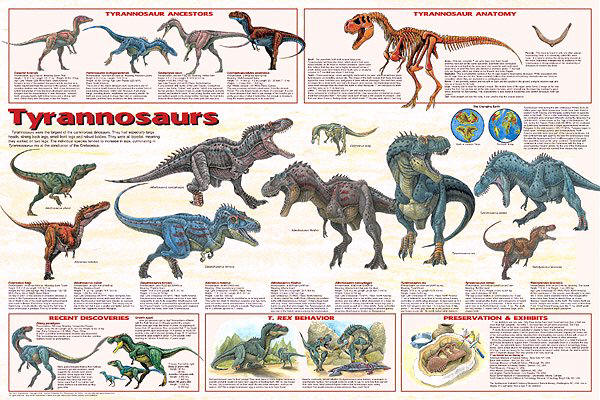|
The name says it all. This group of huge carnivores must have
tyrannically ruled the land during the last part of the Cretaceous, 85
to 65 million years ago. Short but deep jaws with banana-sized sharp
teeth, long hind limbs, small beady eyes, and tiny forelimbs (arms)
typify a tyrannosaur. The Tyrannosauridae included such similar
animals (in rough order of increasing size) as Albertosaurus,
Gorgosaurus, Daspletosaurus, Tarbosaurus, and of
course Tyrannosaurus rex. Tyrannosaurus rex is
the world's most famous dinosaur and almost everyone is familiar with
it. Comparatively few have any knowledge of his relatives - the
other members of the Tyrannosaur family. This introduces T. rex and
nine of his cousins, all listed at left. An informative caption
cites name, pronunciation, size, when he lived, where fossils have
been found and interesting information.
Informative insets explore tyrannosaur ancestors, anatomy,
behavior, recent discoveries and museums where T. rex fossils
may be seen.
Dr. Phillip Currie of the Royal Tyrell Museum in Alberta,
Canada was the technical consultant on this poster. He is
regards as one of the world's leading authorities on tyrannosaurs.
Tyrant dinosaur paleobiology has been
the subject of numerous technical and popular studies and
speculations, due to the fact that they are known from relatively
complete fossils of large to gigantic size and highly derived anatomy. Some authors (Lambe 1917, Colinvaux
1978, Halstead and Halsted 1981, Barsbold 1983, Horner and Lessem
1993, Horner 1994, Horner and Dobb 1997) have suggested that
tyrannosaurids in general or Tyrannosaurus rex
in particular were obligate scavengers, incapable of taking down live
prey. However, Farlow (1993) and Holtz (in press c) have found these
theoretical, ecological and ecomorphological arguments wanting at
present. Instead, as is the case with most large-bodied terrestrial
carnivores, tyrant dinosaurs probably used both scavenging and
predation in order to obtain their food. Carpenter (2000) has
documented an adult specimen of the hadrosaurid
Edmontosaurus annectens with a bite mark attributable by
morphology and stratigraphy to Tyrannosaurus rex:
because this injury shows subsequent regrowth of bone, this wound was
inflicted on a living animal rather than a carcass.
Tyrannosaurid dentition is markedly
heterodont, perhaps indicating a partition of different sectors of the
jaw for different function: scraping for the incisiform premaxillary
teeth versus tearing and crushing for the lateral teeth, for example.
Despite statements to the contrary (Feduccia 1999), the dentition of
tyrannosaurids is not similar to those of other theropods. Instead,
the incrassate (labiolingually expanded) lateral teeth of
tyrannosaurines have greater mediolateral and craniocaudal bending
strength than those of other theropods (Farlow et al. 1991, Holtz in
press c). Erickson and Olson (1996), Erickson et al. (1996), Molnar
(2000), Hurum and Currie (2000), and Holtz (in press c) have argued on
tooth mark and biomechanical evidence that tyrannosaurids were capable
of producing a greater crushing bite than other large theropods, such
as allosauroids and abelisaurids. A very large coprolite from the
Scollard Formation, probably referable to
Tyrannosaurus rex, is nearly half macerated ornithischian bone by
volume (Chin et al. 1998), consistent with the crushing bite model.
Tyrannosaurid forelimbs are extremely
reduced, both in proportion to the body and in terms of digit
development. In contrast, the hindlimbs of tyrant dinosaurs (and in
particular the tibiae and metatarsi) are elongate compared to those of
most other theropods of the same body mass. Indeed, the hindlimb
proportions of tyrannosaurids, ornithomimosaurs, and the gracile
ceratosaur Elaphrosaurus form a continuous
allometric trend, suggesting that the tyrant dinosaurs had a greater
cursorial ability than other large-bodied theropods (such as
allosauroids and spinosauroids) (Holtz 1995, Carrano 1998, Paul 2000).
However, Farlow et al. (1995) have calculated that at extremely high
speeds an adult Tyrannosaurus rex would be
subjected to fatal damage if it fell, suggesting that very large
individual tyrannosaurids may not have been as cursorial as younger or
smaller specimens.
Currie (2000) reports the discovery of
at least nine individuals of Albertosaurus
sarcophagus from the same quarry; these were of different
ontogenetic stages, suggesting that at least some tyrannosaurid taxa
may have been gregarious. |
